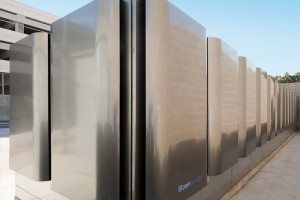New York January 12, 2016

We first reported in 2010 on the fuel cell technology created by Bloom Energy Founder and CEO, inventor and NASA rocket scientist, K. R. Sridhar, who invented a new fuel cell that pumps oxygen into the Bloom Box along with fuel (oil, natural gas, biofuel, solar, carbon-neutral landfill fuel, etc.) that combine to produce electricity.
A huge environmental savings in terms of impact but at what costs?
Electric power combined with other sources still poses risks in lieu of a more dangerous possibility. Last year, The New York Times reported terrorists or a hostile foreign state could take down the American power grid either by a cyber-attack or by an electromagnetic pulse attack. Could these attacks focused on a larger source like the grid also target smaller but more influential financial centers like Morgan Stanley’s global base of operations?
Based on Ted Koppel’s book,“Lights Out: A Cyber-attack, a Nation Unprepared, Surviving the Aftermath,” one of America’s most experienced and best-known journalists, attempted to show readers why the danger is real.

Power plants and factories are increasingly at risk by employing industrial control systems that are vulnerable to hacks. The Department of Homeland and Security’s Industrial Control Systems Cyber Emergency Response Team (ICS-CERT) issued this particular warning after increase in cyber-attacks occurred the past year.

“We see more and more that are gaining access to that control system layer,” Marty Edwards, who runs the Department of Homeland Security’s Industrial Control Systems Cyber Emergency Response Team.
Fuel cell systems, whether grid tied or grid independent provide premium power without voltage sags, surges, and frequency variations that can impact computer systems. In addition to power, byproduct heat from a fuel cell can be used at the end user facility for space heating, water heating, and chilling. When supplementing grid power, fuel cells reduce peak demand and lower energy bills. In some areas, fuel cell power is even cheaper than grid electricity. Power purchase agreements, offered by many of the major fuel cell companies, can lock in the cost of fuel cell power for a specified period, generating cost savings over the term of the contract. On top of everything, fuel cells produce little to no polluting emissions making fuel cells the cleanest energy generation technology available today.


Morgan Stanley’s second project with Bloom Energy demonstrates how clean energy can be deployed in urban areas like Times Square
The fuel cell project at 1585 Broadway is expected to be fully operational in late 2016 and will provide approximately 750 kW of 24×7 high quality power to the Morgan Stanley building, equal to approximately 6 million kWh of clean electricity each year.
Bloom Energy’s solid oxide fuel cell (SOFC) technology converts fuel into electricity through a high efficiency non-combustion process that generates clean and reliable on-site power, reducing emissions of greenhouse gasses compared to traditionally generated and transmitted electricity.
“Morgan Stanley is committed to investing in technologies that minimize our impact on the environment,” said Chief Operating Officer Jim Rosenthal. “Following on the success of our fuel cell installation in Purchase, NY, this project further exemplifies how we can improve the sustainability and resiliency of our facilities, while controlling costs and being responsible to our business, our shareholders and our planet.”
“The recent Paris Climate Accord calls on government and business leaders to reimagine the way we power the world, and this project in the heart of Manhattan demonstrates how clean distributed energy can be deployed onsite, even in urban areas,” said KR Sridhar, principal co-founder and CEO of Bloom Energy. “We applaud Morgan Stanley for their continued commitment to clean energy as well as Governor Cuomo’s administration and NYSERDA for their work to drive adoption of clean distributed generation.”
“Partnerships between the State and private sector have made New York a global leader in reducing greenhouse gases and advancing clean energy solutions, and will continue to play a vital role in transforming our energy system,” said John B. Rhodes, President and CEO of NYSERDA said. “This project is an example of how new and innovative technologies will help us achieve Governor Cuomo’s vision of an energy system that is cleaner, more resilient and more affordable for all New Yorkers.”
Bloom Energy currently has over 200 projects across the United States and in Japan, including ten operating projects in New York State.












